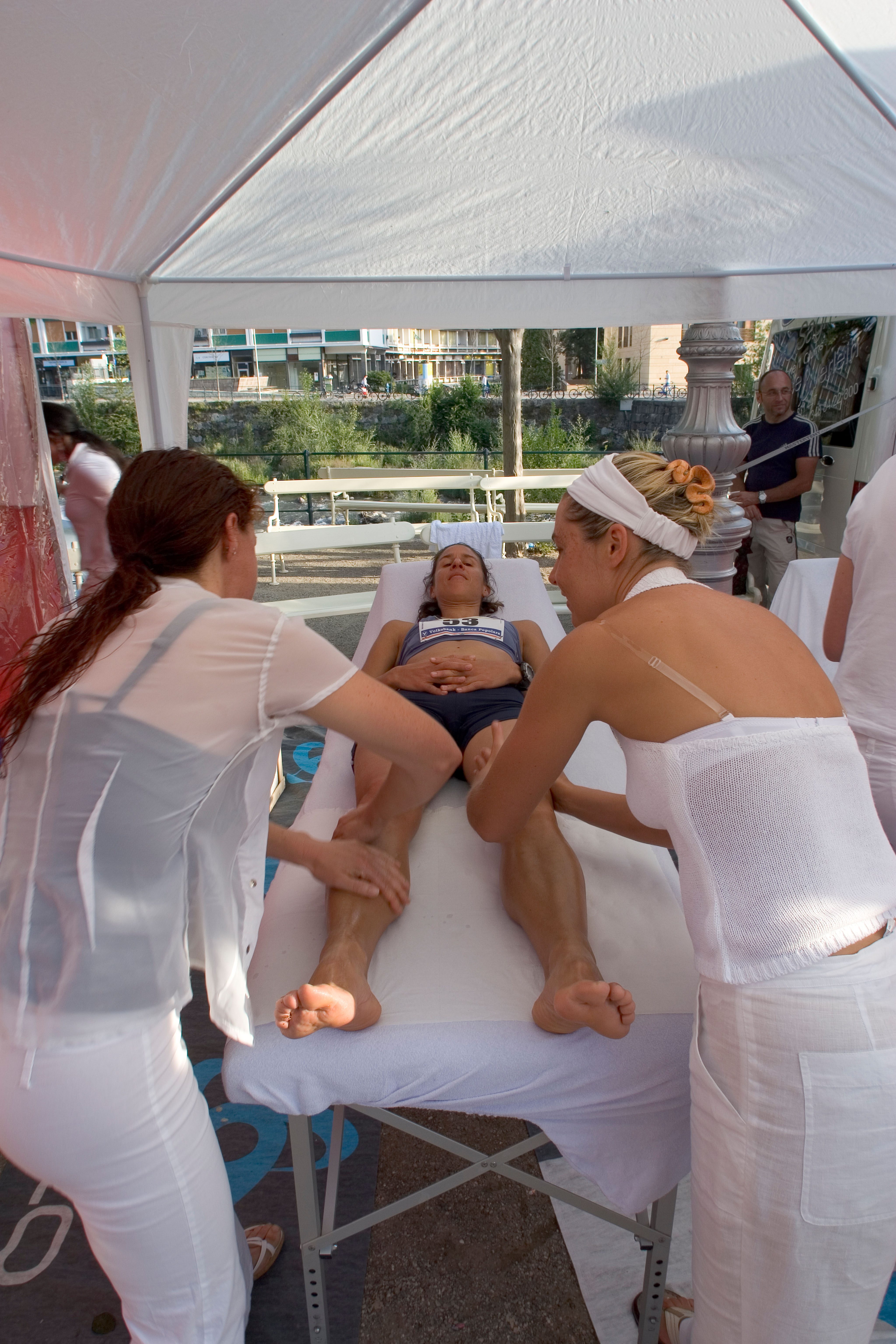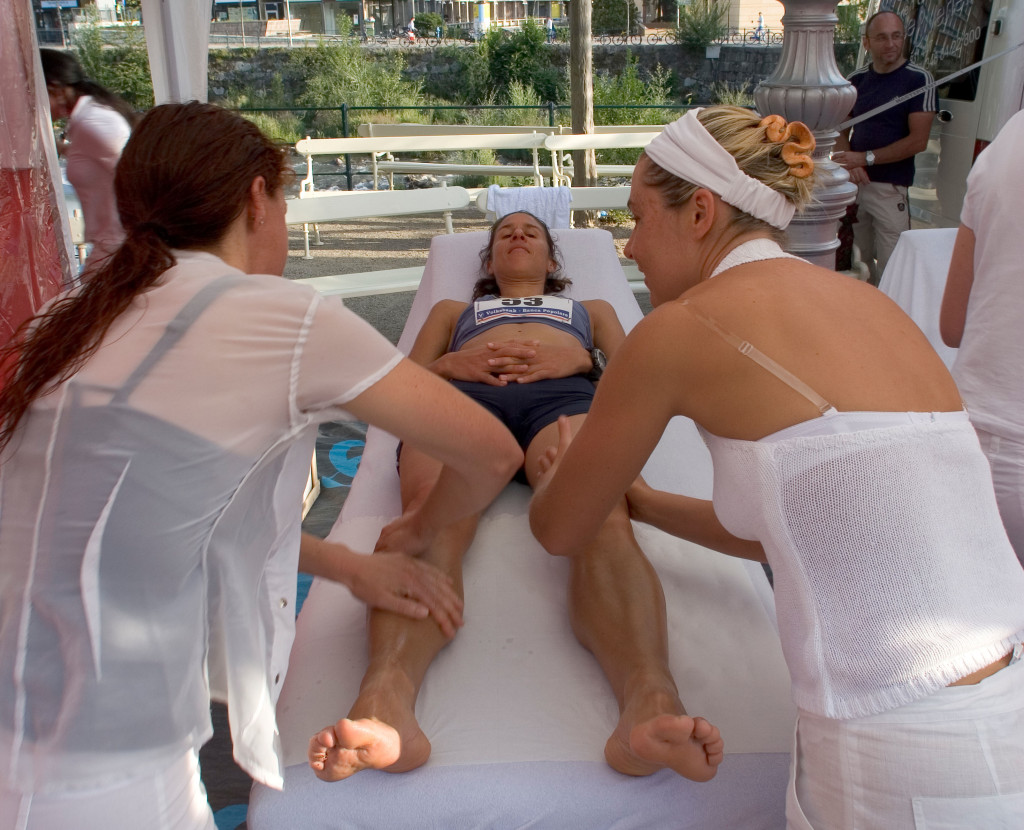Post-run recovery: More isn’t always better

It’s a bright Sunday morning, and you’re finishing up a long, hard run – a two-hour hammerfest that has seared your lungs and fried your legs. Fortunately, you know what to do next. First, the cold-water soak to squeeze blood from tender muscles and quench inflammation, while sipping on a protein-packed smoothie to kick-start muscle synthesis. Then pull on the compression socks, pop some antioxidants and an Advil, and call to schedule a massage.
| PHASE | WEEKS | TRAINING FOCUS | RECOVERY PLAN |
| Base | 1-6 | Building mileage and endurance | Sleep and eat well. Avoid extra recovery aids like ice baths and compression socks unless you have an injury developing. |
| Preparation | 7-12 | Longest runs and hardest workouts | Add extra recovery once or twice a week, e.g. ice bath after long intervals and compression socks after long run. |
| Peak | 13-16 | Ready to race | Pull out all the stops to speed recovery after all workouts and long runs, e.g. book a massage as time and budget permit! |
That evening, you feel pretty good. Thanks to your hardcore recovery routine, your legs feel more like you did a relaxed one-hour jog rather than a two-hour burner. You’ve managed to trick your body into subtracting an hour of fatigue. But as you drift to sleep, a heretical thought floats past: If the end result is the same, why didn’t you just run for an hour and skip all the recovery stuff?
For years, we’ve been lectured about the importance of proper post-run recovery, and we’ve enthusiastically embraced a growing array of recovery tools. Recently, top coaches and scientists have begun to question whether we’ve gone too far. After all, the whole point of training is to stress your body, to force it to repair itself and come back stronger. “All the adaptations that you see in training are caused by this stress to the body,” explains Jonathan Leeder, a physiologist with the English Institute of Sport. The result: if you use recovery aids like ice baths and anti-inflammatories to reduce your training stress too much, you may end up wiping out some of the training benefit from your workout in the process.
Leeder was among the first sports scientists to sound the warning about the downside of “over-recovery,” in the lead-up to the 2012 Olympics, but evidence had been accumulating for several years before that. A small Japanese study in 2006 found that volunteers made smaller fitness and strength gains during a six-week training program if they took ice baths after their workouts. The ice-baths suppressed the inflammation that otherwise would have served as a signal to the body to adapt. Similarly, other studies have found that repair processes in your muscles are slower 24 hours after a hard workout if you take anti-inflammatory drugs like ibuprofen, and that antioxidants like vitamins C and E delayed muscle recovery in elite athletes.
One of the most intriguing findings relates to the famous “refuelling window” after exercise. It’s well-established that your body is most receptive to restocking its carbohydrate stores and kick-starting muscle repair if you take in food between 30 minutes and two hours after a run – and that’s crucial if you’re training twice a day and need to recover within hours. But most of us have more modest recovery needs. A study at the University of Massachusetts found that when volunteers consumed a recovery shake that exactly matched the number of calories they’d just burned in a treadmill workout, they failed to see the expected improvement in insulin sensitivity. By immediately replacing the calories, they ensured that their bodies didn’t feel any stress – and as a result, their bodies didn’t bother to adapt and get fitter.
None of this is an argument to ignore recovery – or, worse, starve yourself after a hard run. Instead, experts like Trent Stellingwerff, a coach and physiologist at the Canadian Sport Institute in Victoria, B.C. argue for a more balanced approach. “I have a continuum for recovery, where there are times you might emphasize it and times you might not emphasize it,” he says. After an easy run, there’s definitely no need to down sports bars and take ice baths; your natural recovery processes can (and should) handle it.
After a long run or a punishing interval workout, on the other hand, it’s more of a judgment call. Stellingwerff and Leeder both recommend “periodizing” recovery efforts. During periods of heavy training, when you hope to gain the most fitness, limit your use of recovery aids. Depending on how hard you’re training, this might mean focusing only on good nutrition and plentiful sleep; or it might mean using ice baths and compression garments, but only once or twice a week after your hardest sessions. Then, as you get closer to goal races, ramp up your recovery efforts and do everything possible to feel fresh on the start line. “In a competition, where you’re not looking for gains and just trying to perform optimally, there’s nothing to lose from these strategies,” Leeder says.
This advice may sound counterintuitive when we see professional athletes engaged in an ever-escalating race to acquire the most sophisticated and expensive recovery machines – liquid-nitrogen-fuelled cryosaunas, pneumatic leg-compression tubes, and endless varieties of high-tech clothing and exotic pills. But if there’s a secret to the success of elite runners, it’s not their recovery tools – it’s the hard workouts they do to earn their recovery. So if you’re feeling tired and heavy-legged after your next workout, don’t panic: that’s exactly how you’re supposed to feel.



